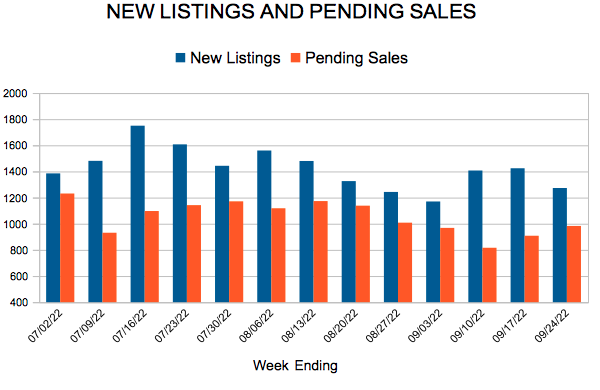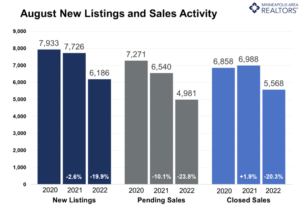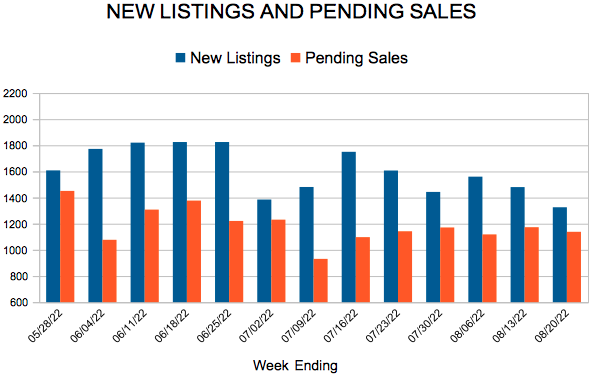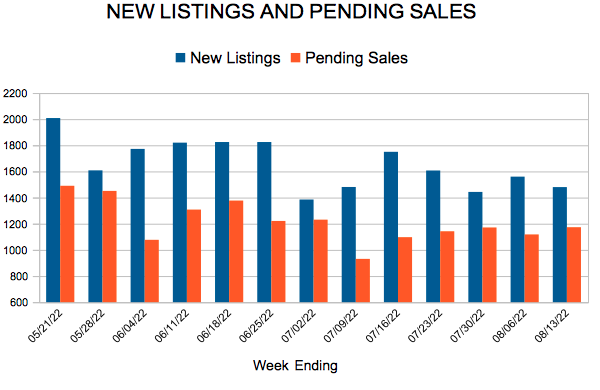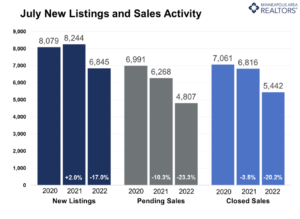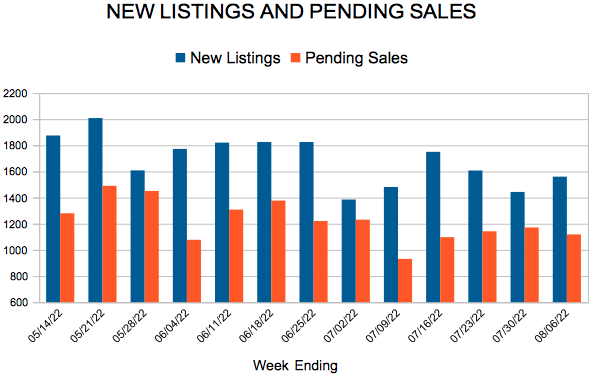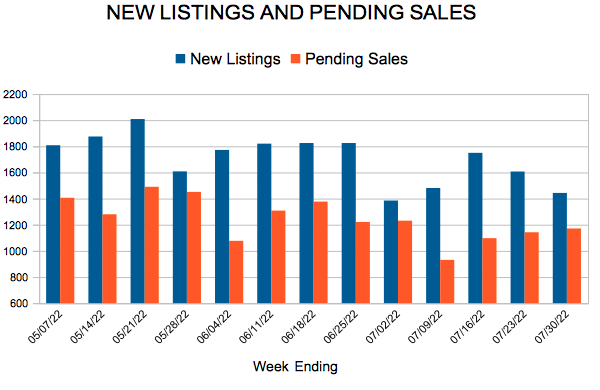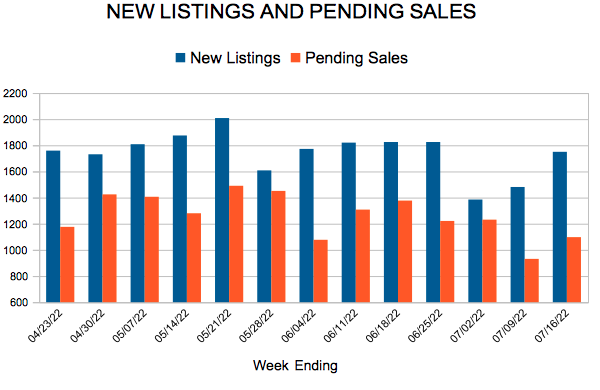New Listings and Pending Sales
Home price growth slows as market times rise and demand cools
- Median sales price was up just 5.6 percent to $369,750, the smallest gain since June 2020
- Buyer activity pulled back as pending sales fell 23.8 percent
- Homes took 26 days to sell, 18.2 percent longer than the 22 days last August
(September 16, 2022) – According to new data from Minneapolis Area REALTORS® and the Saint Paul Area Association of REALTORS®, both sales and listing activity were down in August while home price growth has slowed to its lowest level in two years but remains positive. Sellers also accepted lower offers as market times rose.
Inventory & Home Prices
The median home price in the Twin Cities reached $369,750 but the year-over-year growth rate is slowing. While prices are not falling, they’re not rising as quickly as they were. The 5.6 percent price growth in August is below the roughly 8.0 to 16.0 percent gains seen over the last two years. The deceleration in price growth likely reflects the pullback in demand caused by higher interest rates and economic uncertainty. Closed sales were down 20.3 percent in August compared to last year. Buyers also still face low inventory and limited options, although there’s evidence that’s changing.
“We’re seeing a less competitive landscape as the market has slowed given current interest rates,” said Denise Mazone, President of Minneapolis Area REALTORS®. “But the silver lining is that a less frenzied market could spell more inventory and opportunity for persistent buyers.”
August ended with 8,552 homes for sale, nearly flat compared to last year. Although the region is still a seller’s market, the momentum has been shifting back towards a more balanced marketplace. Month’s supply of inventory rose 13.3 percent to 1.7 months.
Sales & Listings
Buyer activity has softened compared to recent years. This is partly caused by higher mortgage rates, but it also reflects demand being pulled forward (i.e. sales that would’ve occurred in 2022/23 instead took place in 2020/21). August showed 4,981 signed purchase agreements, 23.8 percent short of 2021 levels and the lowest August figure since 2014. But seller activity reached its lowest level since August 2012. The easing of demand has impacted how quickly homes sell. Homes remained on market for an average of 26 days, 18.2 percent longer than last August.
“Sellers may notice that their homes are taking an extra few days to go under contract,” according to Mark Mason, President of the Saint Paul Area Association of REALTORS®. “But nobody talks about the fact that even this slower pace is still fast historically. A cooling of red-hot demand and a less intense landscape means a more sustainable and accessible marketplace.”
Sellers listed 6,186 properties on the market, 19.9 percent fewer than last August. Many Baby Boomers are choosing to age in place and aren’t listing their homes. Some homeowners are reluctant to trade into a higher mortgage rate on a higher priced home given economic uncertainty. And, some sellers are choosing to wait given their lack of options once their home sells. The industry has also underbuilt housing for about 15 years, and it will take time to rise out of that deficit.
Location & Property Type
Market activity varies by area, price point and property type. New home sales fell 11.0 percent while existing home sales were down 20.3 percent. Single family sales fell 19.7 percent, condo sales declined 26.7 percent and townhome sales were down 17.4 percent. Sales in Minneapolis decreased 23.3 percent while Saint Paul sales fell 18.9 percent. Cities like Monticello, Golden Valley, and Orono saw the largest sales gains while Stillwater, Chanhassen, and Fridley had lower demand than last year.
August 2022 Housing Takeaways (compared to a year ago)
- Sellers listed 6,186 properties on the market, a 19.9 percent decrease from last August
- Buyers signed 4,981 purchase agreements, down 23.8 percent (5,568 closed sales, down 20.3 percent)
- Inventory levels dropped 1.3 percent to 8,552 units
- Month’s Supply of Inventory rose 13.3 percent to 1.7 months (4-6 months is balanced)
- The Median Sales Pricerose 5.6 percent to $369,750
- Days on Market rose 18.2 percent to 26 days, on average (median of 15 days, up 50.0 percent)
- Changes in Sales activity varied by market segment
- Single family sales decreased 19.7 percent; Condo sales were down 26.7 percent & townhouse sales fell 17.4 percent
- Traditional sales declined 20.0 percent; foreclosure sales fell 20.8 percent; short sales were up 40.0 percent (from 5 to 7)
- Previously owned sales decreased 20.3 percent; new construction sales declined 11.0 percent
New Listings and Pending Sales
New Listings and Pending Sales
Higher rates continue to cool demand, home prices still on the rise
- Median sales price was up 7.1 percent to $375,000, the slowest increase since June 2020
- Buyer activity was down, pending sales fell 23.3 percent
- Homes took 22 days to sell, 15.8 percent longer than the 19 days last July
(August 15, 2022) – According to new data from Minneapolis Area REALTORS® and the Saint Paul Area Association of REALTORS®, buyers in the Twin Cities have struggled to keep pace with the highs of 2021. Pending sales were down 23.3 percent in July compared to last year as buyers signed 4,807 purchase agreements. Buyers have been hampered by increased mortgage rates, still-low inventory, strong home prices and some economic uncertainty.
Sales & Listings
Buyer activity has been softening for 11 of the last 12 months as most acknowledge the frenzied demand of 2020 and 2021couldn’t last. July’s pending sales volume was 12.8 percent lower than July of 2019, reflecting affordability and supply challenges but also hinting at how demand was expedited from 2022/3 into 2020/1. “Many Twin Citizens eager to take advantage of historically low rates and purchase a home leapt at the chance,” said Denise Mazone, President of Minneapolis Area REALTORS®. “Combined with rising rates, that’s left a hole in our buyer pool this year, but there is still plenty of pent-up demand for homes. Plus there’s evidence rates are easing somewhat.” There has not been an influx of supply onto the market. Home sellers listed 6,845 homes last month, down 17.0 percent from last July. Selling activity has been fairly stable overall since 2020, but continuously lagging behind the supply needed to fuel the market demand, until the recent slowdown in sales.
Inventory & Home Prices
Homes in the metro sold for a median of $375,000 last month, 7.1 percent more than last July. That was the slowest growth rate in two years and amounts to $205 per square foot. The recent downshift in buyer activity has offered a small reprieve for persistent buyers thirsty for inventory and less competition. The metro ended July with 8,694 homes for sale, 4.5 percent more than last July. In a welcome development for buyers, inventory levels have grown for three consecutive months and months supply rose to 1.7. That suggests the supply squeeze is loosening but it’s important to recognize we’re still in a strong seller’s market. “Aspiring home buyers still face competition and multiple offers, just slightly less so than the last couple years, “according to Mark Mason, President of the Saint Paul Area Association of REALTORS®. “So while the market has rebalanced slightly, it still favors sellers.”
Location & Property Type
Market activity varies by area, price point and property type. New home sales fell 18.8 percent while existing home sales were down 16.4 percent. Single family sales fell 18.1 percent, condo sales declined 24.5 percent and townhome sales were down 20.8 percent. Sales in Minneapolis decreased 17.5 percent while Saint Paul sales fell 25.0 percent. Cities like Monticello, Golden Valley, and Orono saw the largest sales gains while Stillwater, Chanhassen, and Fridley had lower demand than last year.
July 2022 Housing Takeaways (compared to a year ago)
- Sellers listed 6,845 properties on the market, a 17.0 percent decrease from last July
- Sellers signed 4,807 purchase agreements, down 23.3 percent (5,442 closed sales, down 20.2 percent)
- Sellers levels grew 4.5 percent to 8,694 units
- Month’s Supply of Inventory rose 13.3 percent to 1.7 months (4-6 months is balanced)
- The Median Sales Price rose 7.1 percent to $375,000
- Days on Market rose 15.8 percent to 22 days, on average (median of 11 days, up 57.1 percent)
- Changes in Sales activity varied by market segment
- Single family sales decreased 18.1 percent; Condo sales were down 24.5 percent & townhouse sales fell 20.8 percent
- Traditional sales declined 18.9 percent; foreclosure sales fell 12.5 percent; short sales were down 14.3 percent
- Previously owned sales decreased 16.2 percent; new construction sales declined 18.8 percent
New Listings and Pending Sales
New Listings and Pending Sales
New Listings and Pending Sales
New Listings and Pending Sales
- « Previous Page
- 1
- …
- 17
- 18
- 19
- 20
- 21
- …
- 28
- Next Page »
